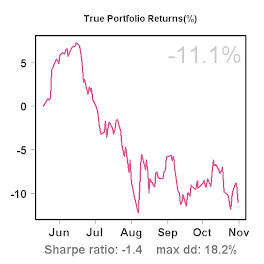Longstoch-ST Max Drawdown per Trade
Yesterday I posted some results on the average return per trade, and in this post I'll look at the average risk (in terms of drawdown) per trade. The figure below shows for each of the Longstoch-ST trades the maximum drawdown of the trade. E.g. if a position was opened for $100, closed for $110, and moved all the way down to a low of $95 in between, the max drawdown of that trade would be 5%.
Looking at the figure, we can see that most trades had a max drawdown between 0 and 6%, while three were a lot larger than the rest (-18%, -13% and -17%). Similar to calculating the expectancy (average return), we can calculate the average max drawdown by taking the average of the length of the bars in the figure, which happens to be -2.73%. We can use the bootstrap to estimate a confidence interval:
95% Percentile [-3.60 , -2.00] ; BCa [-3.79 , -2.10]
99% Percentile [-3.93 , -1.82] ; BCa [-4.21 , -1.94]
(100,000 replications)
These ranges are quite acceptable for me, in particular when taking into account that the drawdown as a percentage of equity is half of these numbers (because the system enters each position with 50% of equity).
The only things that are a little worrying are the few exceptionally large drawdowns. And here we can see the benefits of trading a portfolio of systems! Suppose the weight of this system in my portfolio would be 40%, in that case an 18% per trade drawdown would equal to a 3.6% drawdown on equity (18 x 0.5 x 0.4), which I think is large but still manageable nonetheless.
The vendor actually suggests subscribers to consider a stop-loss between 12 and 25% (the latter being the stop-loss imposed by the vendor), but I'll stick to just following the signals as they are issued by the vendor to match the system's C2 track record as closely as possible.


No comments:
Post a Comment